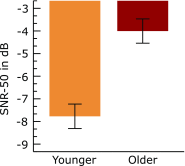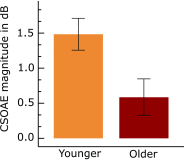Functional Interplay Between the Putative Measures of Rostral and Caudal Efferent Regulation of Speech Perception in Noise
- PMID: 28447225
- PMCID: PMC5532183
- DOI: 10.1007/s10162-017-0623-y
Functional Interplay Between the Putative Measures of Rostral and Caudal Efferent Regulation of Speech Perception in Noise
Abstract
Efferent modulation has been demonstrated to be very important for speech perception, especially in the presence of noise. We examined the functional relationship between two efferent systems: the rostral and caudal efferent pathways and their individual influences on speech perception in noise. Earlier studies have shown that these two efferent mechanisms were correlated with speech perception in noise. However, previously, these mechanisms were studied in isolation, and their functional relationship with each other was not investigated. We used a correlational design to study the relationship if any, between these two mechanisms in young and old normal hearing individuals. We recorded context-dependent brainstem encoding as an index of rostral efferent function and contralateral suppression of otoacoustic emissions as an index of caudal efferent function in groups with good and poor speech perception in noise. These efferent mechanisms were analysed for their relationship with each other and with speech perception in noise. We found that the two efferent mechanisms did not show any functional relationship. Interestingly, both the efferent mechanisms correlated with speech perception in noise and they even emerged as significant predictors. Based on the data, we posit that the two efferent mechanisms function relatively independently but with a common goal of fine-tuning the afferent input and refining auditory perception in degraded listening conditions.
Keywords: ABR; brainstem; contextual encoding; corticofugal; efferent; olivocochlear bundle; otoacoustic emissions.
Conflict of interest statement
Conflict of Interest
The authors declare that they have no conflict of interest.
Source of Funding
All India Institute of Speech and Hearing Research Fund (ARF4.07, 2011-12 ).
Software Used for Statistical Analysis
SPSS v17.
Software Used for Artwork
SPSS v17, Matlab, Inkscape.
Institutional Review Board
Ethical guidelines for bio-behavioural research involving human subjects–AIISH.
Figures








Similar articles
-
Speech-ABR in contralateral noise: A potential tool to evaluate rostral part of the auditory efferent system.Med Hypotheses. 2019 Nov;132:109355. doi: 10.1016/j.mehy.2019.109355. Epub 2019 Aug 8. Med Hypotheses. 2019. PMID: 31604162
-
Right-ear advantage drives the link between olivocochlear efferent 'antimasking' and speech-in-noise listening benefits.Neuroreport. 2015 May 27;26(8):483-7. doi: 10.1097/WNR.0000000000000376. Neuroreport. 2015. PMID: 25919996
-
Speech-in-noise perception ability can be related to auditory efferent pathway function: a comparative study in reading impaired and normal reading children.Braz J Otorhinolaryngol. 2020 Mar-Apr;86(2):209-216. doi: 10.1016/j.bjorl.2018.11.010. Epub 2019 Jan 28. Braz J Otorhinolaryngol. 2020. PMID: 30772249 Free PMC article.
-
The First Jerger Lecture. Contralateral suppression of otoacoustic emissions: an index of the function of the medial olivocochlear system.Otolaryngol Head Neck Surg. 1994 Jan;110(1):3-21. doi: 10.1177/019459989411000102. Otolaryngol Head Neck Surg. 1994. PMID: 8290299 Review.
-
The theory of the organism-environment system: III. Role of efferent influences on receptors in the formation of knowledge.Integr Physiol Behav Sci. 1999 Apr-Jun;34(2):90-100. doi: 10.1007/BF02688715. Integr Physiol Behav Sci. 1999. PMID: 10485609 Review.
Cited by
-
Effect of Efferent Stimulation on the Differential Sensitivity in Individuals with Normal Hearing.Indian J Otolaryngol Head Neck Surg. 2022 Dec;74(Suppl 3):4100-4105. doi: 10.1007/s12070-021-02852-x. Epub 2021 Sep 12. Indian J Otolaryngol Head Neck Surg. 2022. PMID: 36742897 Free PMC article.
-
Effect of Contralateral Acoustic Stimulation on Temporal Processing Abilities in Individuals with Normal Hearing.Indian J Otolaryngol Head Neck Surg. 2023 Jun;75(2):685-691. doi: 10.1007/s12070-022-03420-7. Epub 2022 Dec 30. Indian J Otolaryngol Head Neck Surg. 2023. PMID: 37275046 Free PMC article.
-
The relationship between ipsilateral cochlear gain reduction and speech-in-noise recognition at positive and negative signal-to-noise ratios.J Acoust Soc Am. 2021 May;149(5):3449. doi: 10.1121/10.0003964. J Acoust Soc Am. 2021. PMID: 34241110 Free PMC article.
-
The Medial Olivocochlear Efferent Pathway Potentiates Cochlear Amplification in Response to Hearing Loss.J Neurosci. 2025 Apr 9;45(15):e2103242025. doi: 10.1523/JNEUROSCI.2103-24.2025. J Neurosci. 2025. PMID: 39984203
-
The effect of coffee on contralateral suppression of transient evoked otoacoustic emissions.F1000Res. 2023 Sep 13;11:878. doi: 10.12688/f1000research.122851.2. eCollection 2022. F1000Res. 2023. PMID: 37841827 Free PMC article.
References
MeSH terms
LinkOut - more resources
Full Text Sources
Other Literature Sources

